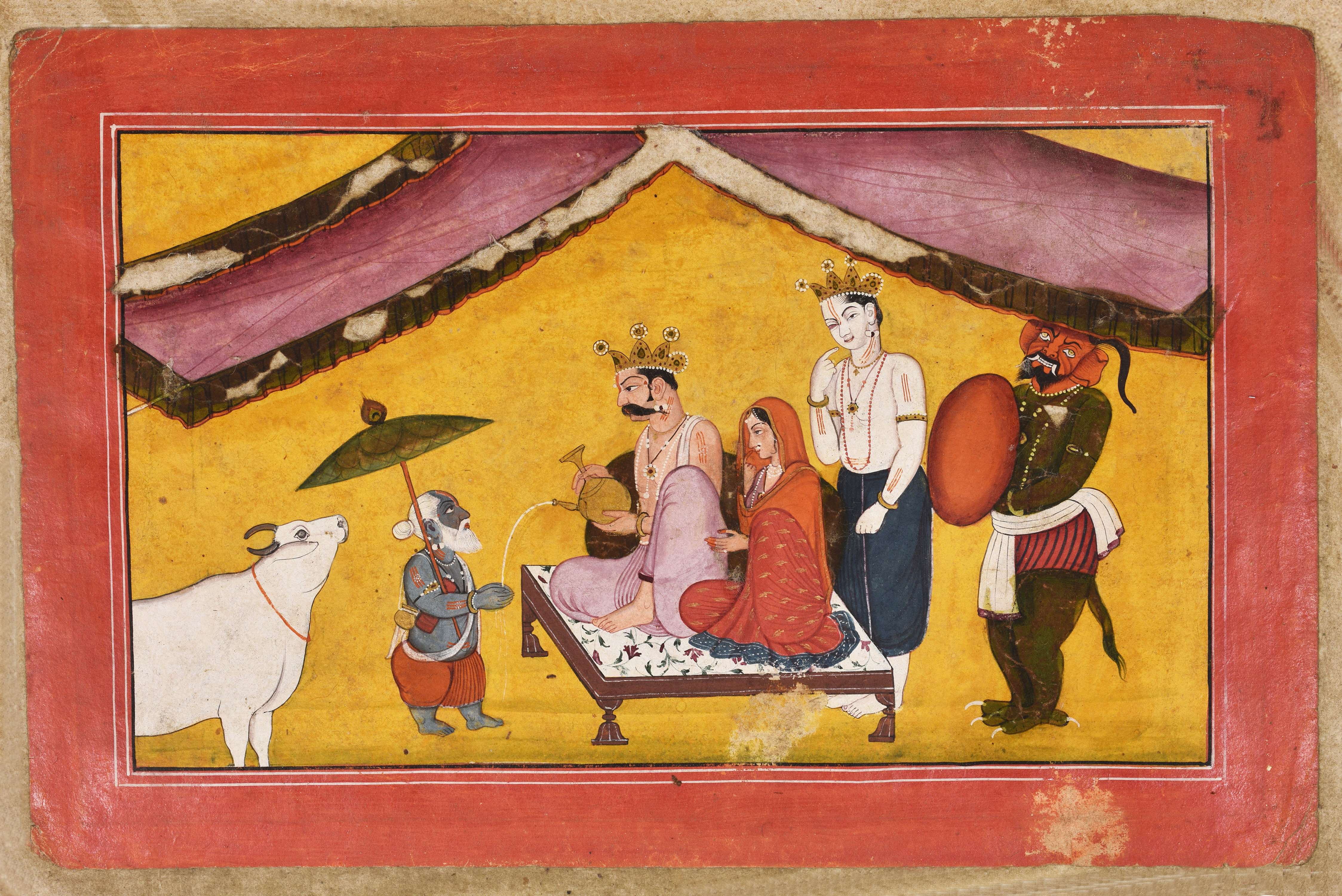Discover, Learn, immerse, Connect
Vishnu as Dwarf asking for Three Steps of Land
This remarkable painting depicting Vishnu as a dwarf and asking for three steps of land finds its origin in Guler, Himachal Pradesh and dates back to 1780 CE. It is 18 cm in length and 28 cm in width. It is currently on display in the Miniature Paintings Gallery of the National Museum, New Delhi.
Miniature paintings in India can be traced back to 750 CE under the rule of Palas where religious teachings of Buddha accompanied by his images were painted on palm leaves. Since these paintings were made on leaves, they had to be miniature in nature. Many decades later a resurgence of miniature paintings was witnessed with the rise of the Mughals who brought the Persian influence into the miniature paintings. Due to political alliances and cultural interactions the art of miniature spread to the Pahari kingdoms, who added their own aesthetic to the largely similar format. Pahari miniatures are known for their soft touch, serenity, inherent symbolism and a superior sense of composition alongside minute detailing. In 1690, Basohli, a hill state on the bank of river Ravi, initiated art of the hill region. Later, major centres of Pahari art developed at Guler, Chamba, Mandi and Kangra.
The Vamana Purana, a medieval Sanskrit text, is one of the eighteen major Puranas of Hinduism. The text is named after one of the incarnations of Vishnu. However, the modern surviving manuscripts superimposed the same story with Shiva as the protagonist. The Vamana avatar has roots in the hymns of Rigveda where Vishnu is described as a benevolent God who defined all there is in the universe in three steps. The giant form of Vamana is also known as Trivikrama which translates to ‘three steps.' Visually, the viewer is pulled towards 'the receding horizon', the King occupying the centre of the space. He is shown proportionally larger and visibly more regal than the lord Vishnu himself. Vishnu as the Vamana challenges stereotypes of size and power to remind one to never judge a book by its cover.
This eye catching miniature painting has been made with bright colors and depicts a story. Vishnu disguised as a dwarf (vamana) visits the court of Raja Bali, who was a devotee of Vishnu but couldn’t recognize him at first in his disguise as a dwarf. Vamana is depicted in the painting with features and attributes that can be recognized to be that of Vishnu’s such as a tilak on his forehead, a peacock umbrella and a peacock feather. Behind him is a cow. The King is seated next to his wife on a pedestal which seems to be decorated with beautiful inlay of precious stones by a technique known as pietra dura or parchin kari. He is shown pouring water out of a vessel with a long spout into the palms of the Vamana. He is wearing a crown embedded with pearls and ruby. The canvas on the right is occupied by a bejeweled Prince and a fearsome guard, both denoting the prestige of the King seated in the middle.
The legend of Vamana inspired the celebration of the festival called Onam. In one of the versions of the legend, Mahabali’s offering of his head to the Vamana is believed to be an act of Mahabali’s devotion due to which Vishnu granted him a boon wherein he would be allowed to revisit the lands and people he previously ruled. The festival of Onam is celebrated annually in Kerala in order to commemorate King Mahabali whose spirit is believed to visit Kerala at the time of Onam.
According to Hindu mythology, the noble demon king gets a ceremony organized in which distributes gifts to display his grandeur and power. Vishnu appears at this ceremony as a dwarf Brahmin named Vamana. When it's his turn to receive a gift, Mahabali asks him to take whichever precious items or gifts he would like to have but Vamana refuses this offer and states that he would simply like to have land equal to the size of his three steps. Mahabali finds this request pretty amusing and grants it. Vamana then grows into a giant. He covers the whole earth with his first step, heaven with the second step and for the third step Mahabali, who by now has realized that its Vishnu, offers his head on which Vamana steps sending the demon king to the netherworld called paatala.
 Government of India
Government of India



